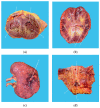FIP1L1-PDGFRα-Positive Loeffler Endocarditis-A Distinct Cause of Heart Failure in a Young Male: The Role of Multimodal Diagnostic Tools
- PMID: 37238279
- PMCID: PMC10217393
- DOI: 10.3390/diagnostics13101795
FIP1L1-PDGFRα-Positive Loeffler Endocarditis-A Distinct Cause of Heart Failure in a Young Male: The Role of Multimodal Diagnostic Tools
Abstract
The presence of the Fip1-Like1-platelet-derived growth factor receptor alpha (FIP1L1-PDGFRα) fusion gene represents a rare cause of hypereosinophilic syndrome (HES), which is associated with organ damage. The aim of this paper is to emphasize the pivotal role of multimodal diagnostic tools in the accurate diagnosis and management of heart failure (HF) associated with HES. We present the case of a young male patient who was admitted with clinical features of congestive HF and laboratory findings of hypereosinophilia (HE). After hematological evaluation, genetic tests, and ruling out reactive causes of HE, a diagnosis of positive FIP1L1-PDGFRα myeloid leukemia was established. Multimodal cardiac imaging identified biventricular thrombi and cardiac impairment, thereby raising suspicion of Loeffler endocarditis (LE) as the cause of HF; this was later confirmed by a pathological examination. Despite hematological improvement under corticosteroid and imatinib therapy, anticoagulant, and patient-oriented HF treatment, there was further clinical progression and subsequent multiple complications (including embolization), which led to patient death. HF is a severe complication that diminishes the demonstrated effectiveness of imatinib in the advanced phases of Loeffler endocarditis. Therefore, the need for an accurate identification of heart failure etiology in the absence of endomyocardial biopsy is particularly important for ensuring effective treatment.
Keywords: FIP1L1–PDGFRA fusion gene; Loeffler endocarditis; cardiac imaging; heart failure; hypereosinophilic syndrome.
Conflict of interest statement
The authors declare no conflict of interest.
Figures




References
-
- Valent P., Klion A.D., Horny H.P., Roufosse F., Gotlib J., Weller P.F., Hellmann A., Metzgeroth G., Leiferman K.M., Arock M., et al. Contemporary consensus proposal on criteria and classification of eosinophilic disorders and related syndromes. J. Allergy Clin. Immunol. 2012;130:607–612. doi: 10.1016/j.jaci.2012.02.019. - DOI - PMC - PubMed
Publication types
Grants and funding
LinkOut - more resources
Full Text Sources
Research Materials
Miscellaneous

